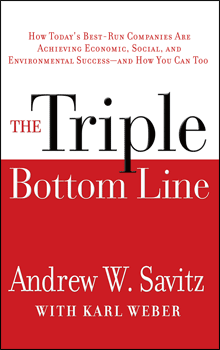The Basics of CSR Reporting
/ As I mentioned in an earlier post on The Changebase, one of the projects I’ve been working on this semester is a CSR Reporting Directed Study for a Fortune 300 company.
As I mentioned in an earlier post on The Changebase, one of the projects I’ve been working on this semester is a CSR Reporting Directed Study for a Fortune 300 company.
This company (who will remain nameless since the project is still ongoing) contacted the Boston University School of Management and asked if the school would put together a team of MBA consultants to evaluate the company’s current CSR report and make recommendations for changes or improvements. Since CSR reporting is such an important and popular topic these days, I really wanted to be a part of this project. And, since the opportunity was presented as not just a consulting gig, but also as a class, I knew there’d be some good learning too.
Over the course of the last few months, I’ve spent the majority of my time with my team (there are five of us) learning about The Global Reporting Initiative (GRI).
As the area of CSR reporting moves forward and becomes more solidified, the GRI has emerged as the leading, best-in-class standard for how companies should address their environmental and social impacts. Much like LEED has become the “gold standard” in green building, the GRI has emerged as the reporting framework that most companies use. While this doesn’t mean that the GRI framework is perfect, it does mean that the GRI is the most popular guide for companies that want to report on these issues and don’t know where to start.
While there are some folks who don’t like the GRI, in general I believe its reporting framework provides a comprehensive, detailed outline of the targets and impacts every company should be measuring. Its framework consists of 79 indicators that are measured along 6 dimensions:
- Economic
- Environmental
- Labor Practices and Decent Work
- Human Rights
- Society, and
- Product Responsibility.
Under each category, the GRI lists very specific metrics that companies should use to quantify and qualify their impacts along each dimension. For example, under Human Rights, one of the indicators is “Operations identified as having significant risks for incidents of child labor, and measures taken to contribute to the elimination of child labor”. You can imagine how hard it is for a global business with operations worldwide to wrap its arms around this kind of question.
And yet, it is understandably crucial for any business to understand something like this.
In addition to the indicator questions, the GRI lays out principles for content and quality – which are essentially a roadmap for how to determine what should be in a report and how to tell the company’s sustainability story. These are:
Principles for Content:
- Materiality
- Stakeholder Inclusiveness
- Sustainability Context
- Completeness
Principles for Quality:
- Balance
- Comparability
- Accuracy
- Timeliness
- Clarity
- Reliability.
Without getting into too much detail, you can probably guess that some of these principles are easier to follow than others. Yet, the more I learn, the more I realize that absolutely every single one of them is crucially important.
The fun part of this consulting project has been poring over the company’s CSR report and looking at it through the lens of each content and quality principle. Over the last few weeks, we’ve been asking ourselves questions like:
- How well does the company present balanced (that is, positive and negative) information?
- What kind of stakeholder analysis has the company done? Does the report speak to the right audience?
- Is the report complete? If not, what’s missing?
It’s really been a lot of fun to take a real-life case study and evaluate it according to what we’ve learned.
And what I’m learning is that CSR reporting is a lot harder than you might think!
Another highlight of the project was having the chance to meet Andy Savitz, a very well-known sustainability consultant and author of The Triple Bottom Line. Andy is incredibly experienced when it comes to CSR reporting, and he was kind enough to sit down with me and my team to talk about best practices in this area. Since this post is about The Basics, I thought I’d share a few words of wisdom from Andy:
A CSR Report is a Living Document: My sense is that some companies want to look at their CSR report much like they do an annual report – it’s published once a year and that’s it. But in a field as new as CSR reporting, many CSR Directors are still getting a handle on what they should be measuring, let alone actually being able to report on it. And since companies are still solidifying what to report on, they’re finding that the data they collect isn’t always perfect.
According to Andy, that’s more than ok. A CSR report should not just be about reporting the good stuff, nor should it just be focused on the past. A good CSR report should focus on being aspirational and strategic, and it should present both the good and the not-so-good (also known as “Opportunities” or “Room for Improvement”).
This leads to a second important point: A Balanced CSR Report is a Trust-Builder. Interestingly, while companies might shy away from sharing negative information, the more transparent a company can be about the good, the bad and the ugly, the more trust it will earn from its stakeholders. Andy gave the example of a company that reported its overseas employees had been offered 13 bribes – and that they turned down 9 of them.
Sure, a CSR department might cringe at the thought of reporting this. But in actuality disclosing this information improved the company’s image and reputation because everything was framed as a work-in-progress. Most audiences, it turns out, aren’t looking for immediate perfection – they just want to know that you’re working on it.
So there you have it – The Basics of CSR Reporting. In truth, there is still so much more that I’m learning – in a month I’ll probably be able to come back and update this post! But I hope this helps lay the groundwork for you as you learn about this topic.
As for my consulting project, my team and I head to their corporate headquarters in late January to present our findings and recommendations. The goal is for their CSR department to take our feedback and incorporate it into their upcoming 2010 report. It’ll be interesting and exciting to see how their new report differs from their old one. I’ll keep you posted!
(By the way, if this post was helpful be sure to check out other posts I've written on "The Basics" - and let me know if there's anything you want to learn next!)


